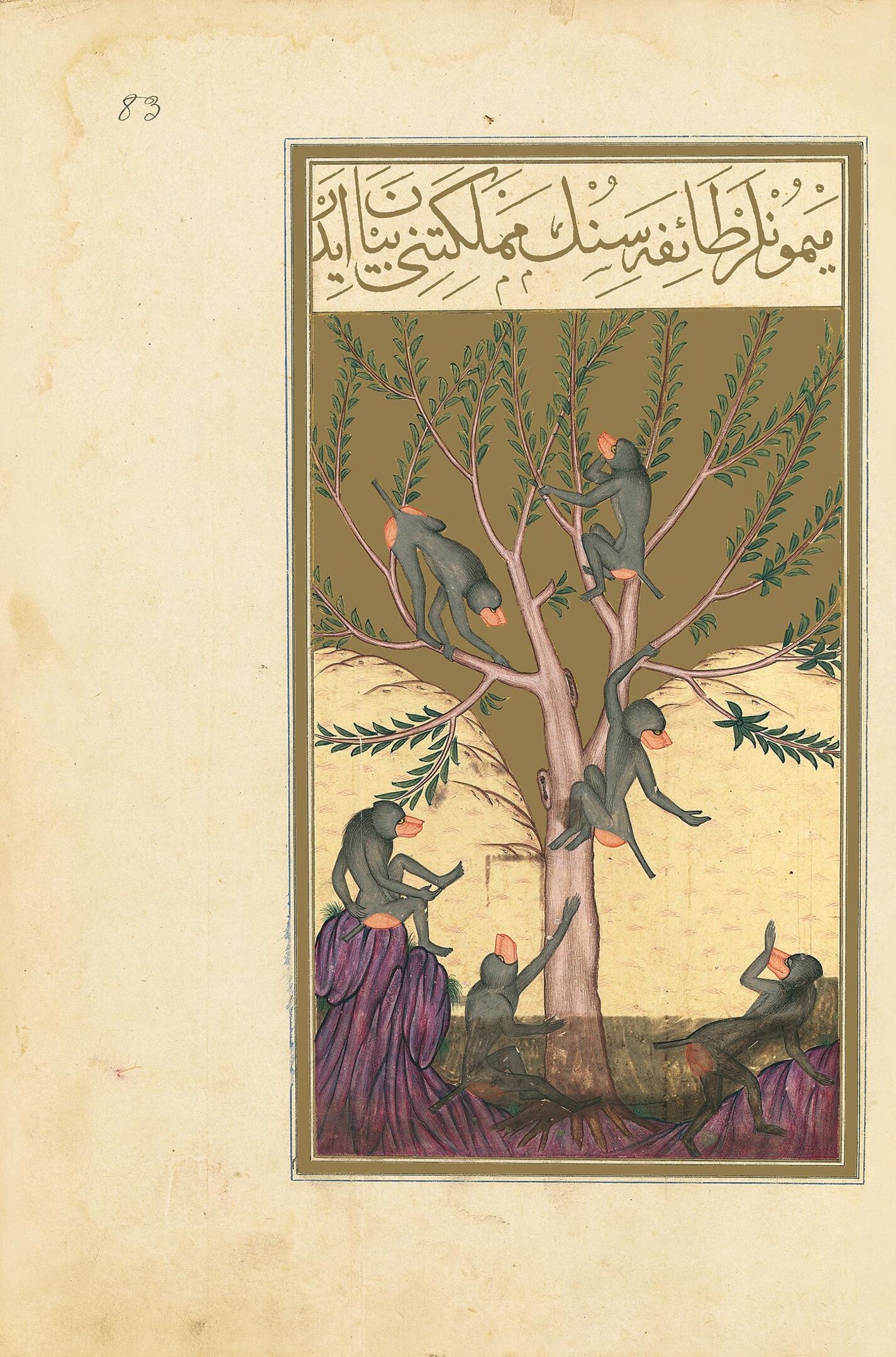The illustration plainly depicts a group of six grey monkeys with pink bottoms, three climbing the large tree dominating the painting while the other three are on the ground and the rocks below. The animals communicate with each other by evident gestures and looks. The title is not explicative enough and it is not possible to understand which land or tribe of monkeys it refers to.
Monkeys often appear as characters in the tales of Kalila and Dimna, the two jackals who are the protagonists of a popular illustrated text in the Medieval Islamic period. There, they are usually associated with other animals or men, as in the story of the king of the monkeys and the tortoise, for example, or the tale of the carpenter and the monkey. One notable exception is a fourteen-century, dispersed and damaged copy of the same text featuring an illustration of a group of monkeys on a riverbed, although it seems unlikely that this painting could have provided the model for the Ottoman painter. A story in The Thousand and One Nights, again in the section dedicated to Sinbad the Sailor that is the source for another miniature in this manuscript (f. 79v), tells how he and his companions started to walk in a valley where a large number of monkeys took refuge by climbing the palm trees around them. The men threw stones at them and the animals defended themselves by picking coconuts and hurling them in turn at Sinbad and his men. In the illustration, however, there are neither coconuts nor palm trees therefore the identification with Sinbad’s story is unlikely. In addition, since the Kitab al-bulhan lacks this painting it can provide no further clues as to its understanding.
Stefano Carboni
The Metropolitan Museum of Art
Curatorial Assistant in Islamic Art
(Fragment of the Book of Felicity commentary volume)

The illustration plainly depicts a group of six grey monkeys with pink bottoms, three climbing the large tree dominating the painting while the other three are on the ground and the rocks below. The animals communicate with each other by evident gestures and looks. The title is not explicative enough and it is not possible to understand which land or tribe of monkeys it refers to.
Monkeys often appear as characters in the tales of Kalila and Dimna, the two jackals who are the protagonists of a popular illustrated text in the Medieval Islamic period. There, they are usually associated with other animals or men, as in the story of the king of the monkeys and the tortoise, for example, or the tale of the carpenter and the monkey. One notable exception is a fourteen-century, dispersed and damaged copy of the same text featuring an illustration of a group of monkeys on a riverbed, although it seems unlikely that this painting could have provided the model for the Ottoman painter. A story in The Thousand and One Nights, again in the section dedicated to Sinbad the Sailor that is the source for another miniature in this manuscript (f. 79v), tells how he and his companions started to walk in a valley where a large number of monkeys took refuge by climbing the palm trees around them. The men threw stones at them and the animals defended themselves by picking coconuts and hurling them in turn at Sinbad and his men. In the illustration, however, there are neither coconuts nor palm trees therefore the identification with Sinbad’s story is unlikely. In addition, since the Kitab al-bulhan lacks this painting it can provide no further clues as to its understanding.
Stefano Carboni
The Metropolitan Museum of Art
Curatorial Assistant in Islamic Art
(Fragment of the Book of Felicity commentary volume)